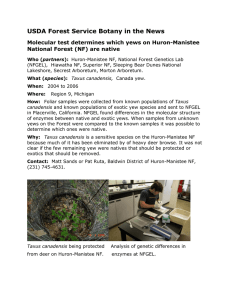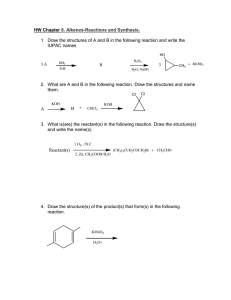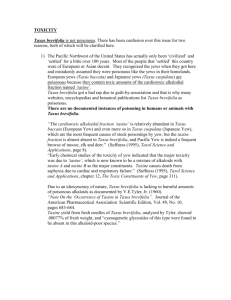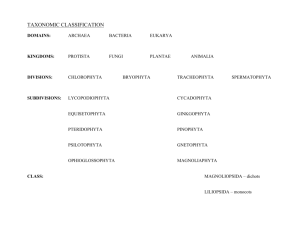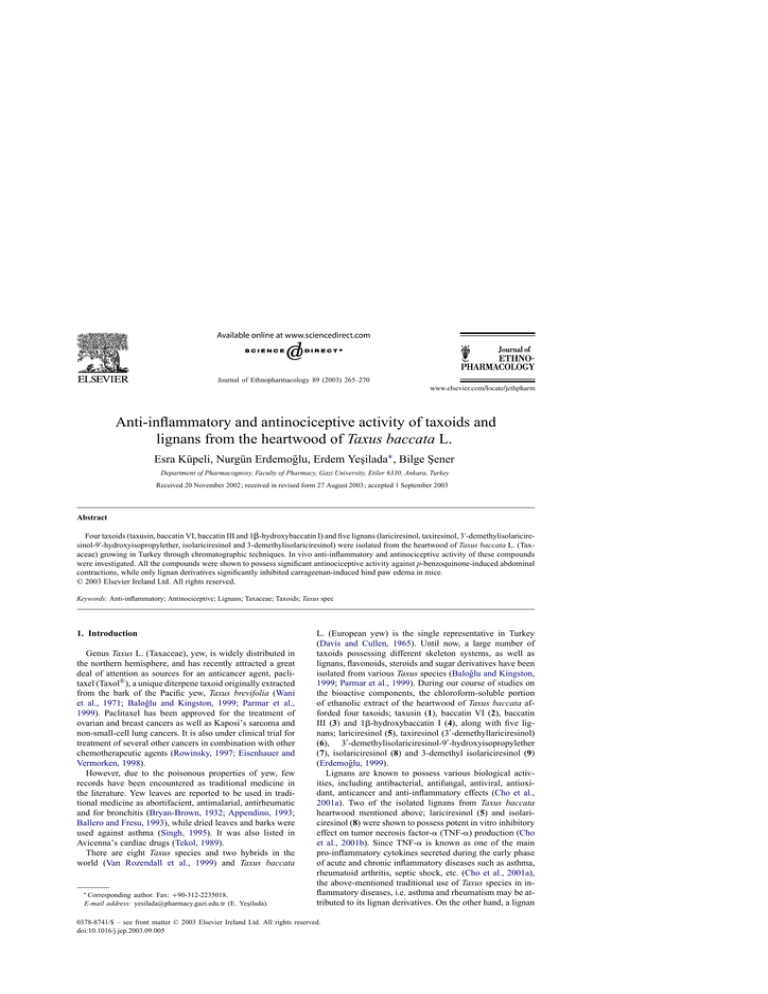
Journal of Ethnopharmacology 89 (2003) 265–270
Anti-inflammatory and antinociceptive activity of taxoids and
lignans from the heartwood of Taxus baccata L.
Esra Küpeli, Nurgün Erdemoğlu, Erdem Yeşilada∗ , Bilge Şener
Department of Pharmacognosy, Faculty of Pharmacy, Gazi University, Etiler 6330, Ankara, Turkey
Received 20 November 2002; received in revised form 27 August 2003; accepted 1 September 2003
Abstract
Four taxoids (taxusin, baccatin VI, baccatin III and 1-hydroxybaccatin I) and five lignans (lariciresinol, taxiresinol, 3 -demethylisolariciresinol-9 -hydroxyisopropylether, isolariciresinol and 3-demethylisolariciresinol) were isolated from the heartwood of Taxus baccata L. (Taxaceae) growing in Turkey through chromatographic techniques. In vivo anti-inflammatory and antinociceptive activity of these compounds
were investigated. All the compounds were shown to possess significant antinociceptive activity against p-benzoquinone-induced abdominal
contractions, while only lignan derivatives significantly inhibited carrageenan-induced hind paw edema in mice.
© 2003 Elsevier Ireland Ltd. All rights reserved.
Keywords: Anti-inflammatory; Antinociceptive; Lignans; Taxaceae; Taxoids; Taxus spec
1. Introduction
Genus Taxus L. (Taxaceae), yew, is widely distributed in
the northern hemisphere, and has recently attracted a great
deal of attention as sources for an anticancer agent, paclitaxel (Taxol® ), a unique diterpene taxoid originally extracted
from the bark of the Pacific yew, Taxus brevifolia (Wani
et al., 1971; Baloğlu and Kingston, 1999; Parmar et al.,
1999). Paclitaxel has been approved for the treatment of
ovarian and breast cancers as well as Kaposi’s sarcoma and
non-small-cell lung cancers. It is also under clinical trial for
treatment of several other cancers in combination with other
chemotherapeutic agents (Rowinsky, 1997; Eisenhauer and
Vermorken, 1998).
However, due to the poisonous properties of yew, few
records have been encountered as traditional medicine in
the literature. Yew leaves are reported to be used in traditional medicine as abortifacient, antimalarial, antirheumatic
and for bronchitis (Bryan-Brown, 1932; Appendino, 1993;
Ballero and Fresu, 1993), while dried leaves and barks were
used against asthma (Singh, 1995). It was also listed in
Avicenna’s cardiac drugs (Tekol, 1989).
There are eight Taxus species and two hybrids in the
world (Van Rozendall et al., 1999) and Taxus baccata
∗ Corresponding
author. Fax: +90-312-2235018.
E-mail address: yesilada@pharmacy.gazi.edu.tr (E. Yeşilada).
L. (European yew) is the single representative in Turkey
(Davis and Cullen, 1965). Until now, a large number of
taxoids possessing different skeleton systems, as well as
lignans, flavonoids, steroids and sugar derivatives have been
isolated from various Taxus species (Baloğlu and Kingston,
1999; Parmar et al., 1999). During our course of studies on
the bioactive components, the chloroform-soluble portion
of ethanolic extract of the heartwood of Taxus baccata afforded four taxoids; taxusin (1), baccatin VI (2), baccatin
III (3) and 1-hydroxybaccatin I (4), along with five lignans; lariciresinol (5), taxiresinol (3 -demethyllariciresinol)
(6), 3 -demethylisolariciresinol-9 -hydroxyisopropylether
(7), isolariciresinol (8) and 3-demethyl isolariciresinol (9)
(Erdemoğlu, 1999).
Lignans are known to possess various biological activities, including antibacterial, antifungal, antiviral, antioxidant, anticancer and anti-inflammatory effects (Cho et al.,
2001a). Two of the isolated lignans from Taxus baccata
heartwood mentioned above; lariciresinol (5) and isolariciresinol (8) were shown to possess potent in vitro inhibitory
effect on tumor necrosis factor-␣ (TNF-␣) production (Cho
et al., 2001b). Since TNF-␣ is known as one of the main
pro-inflammatory cytokines secreted during the early phase
of acute and chronic inflammatory diseases such as asthma,
rheumatoid arthritis, septic shock, etc. (Cho et al., 2001a),
the above-mentioned traditional use of Taxus species in inflammatory diseases, i.e. asthma and rheumatism may be attributed to its lignan derivatives. On the other hand, a lignan
0378-8741/$ – see front matter © 2003 Elsevier Ireland Ltd. All rights reserved.
doi:10.1016/j.jep.2003.09.005
266
E. Küpeli et al. / Journal of Ethnopharmacology 89 (2003) 265–270
fraction possessing 5 and 8 from Fagraea racemosa were
also shown to possess analgesic effect on writhing symptoms in mice (Okuyama et al., 1995).
As related with the above-presented data, this study is designed to investigate in vivo anti-inflammatory and antinociceptive activity of lignans and taxoids isolated from the
chloroform-soluble portion of ethanolic extract of the heartwood of Taxus baccata.
2. Experimental
2.1. Plant material
The heartwood of Taxus baccata L. (Taxaceae) was collected from the vicinity of Camlihemsin, Rize, in June 1995,
from wild trees (altitude 1400 m). An authenticated voucher
specimen (GUE 1560) was kept in the Herbarium of Faculty
of Pharmacy, Gazi University.
2.2. Chemical procedures
2.2.1. General
Column chromatography was performed by using Silica
gel (Kieselgel 60, 0.063–0.200 mm, Art. 7734, Merck) and
Kieselgel 60 F254 (0.5 mm thickness, Art. 5554, Merck)
was used for prep.-TLC. Analytical TLC was performed
on precoated plates (Kieselgel 60 F254 , Art. 5554, Merck)
and visualized under UV254 light, and then sprayed with
anisaldehyde reagent and heated.
2.2.2. Extraction, isolation and purification
The air-dried and powdered heartwood (3078 g) was extracted with 95% EtOH at room temperature. The ethanolic
extract was evaporated to dryness in vacuo and a reddish residue was obtained. The residue was diluted with
H2 O and then extracted with CHCl3 . The CHCl3 -soluble
portion was evaporated under reduced pressure to give a
residue (49 g), which was subjected to column chromatography eluted with increasing polarities of different solvents
(hexane → acetone → CHCl3 → CH3 OH) to give seven
main fractions (frs. I–VII) according to TLC. Each fraction
was further purified by CC, prep.-TLC or recrystallisation.
2.2.3. Isolation of taxoids
Compound 1 was obtained from the fr. II by CC eluting with hexane:acetone (100:0 → 60:40, v/v) mixture
to give seven subfractions (subfrs.). The subfrs. 5–7 was
crystallized from acetone to afford 1 (171 mg, 0.011%).
Fraction III was chromatographed on prep.-TLC with hexane:acetone (70:30, v/v) to give 2 (40.5 mg, 0.0025%).
Fraction IV was crystallized from hexane:acetone (1:1)
mixture to afford 3 (155.4 mg, 0.0096%). Fraction V was
subjected to CC over a silica gel column eluting with
CHCl3 :CH3 OH (100:0 → 90:10, v/v) mixture and then
prep.-TLC with CHCl3 :CH3 OH (80:20, v/v) to provide 4
(76.4 mg, 0.0047%).
2.2.4. Isolation of lignans
Fraction VII (5.65 g) was rechromatographed on a silica
gel column eluting with CHCl3 :CH3 OH (100:0 → 92:8,
v/v) to give 64 subfractions. The subfrs. 11–13 were subjected to prep.-TLC with CHCl3 :CH3 OH (90:10, v/v) to
give 5 (45.7 mg, yield: 0.0028%) and 7 (20.2 mg). From
subfrs. 14–22, 7 (42.6 mg) was also obtained through recrystallization from CHCl3 and total yield of 7 was 62.8 mg
(0.0039%). The subfrs. 47–52 was further separated by
prep.-TLC using CHCl3 : CH3 OH (80:20, v/v) system to
afford 6 (84.6 mg, 0.0052%). The subfrs. 28–33 was crystallized from CHCl3 to give 8 (41.3 mg, 0.0026%). The
subfrs. 58–64 was subjected to a silica gel CC eluting with
CHCl3 :CH3 OH (100:0 → 80:20, v/v) and then prep.-TLC
using CHCl3 :CH3 OH (80:20, v/v) to afford 9 (71.4 mg,
0.0044%).
2.3. Pharmacological procedures
2.3.1. Animals
Male Swiss albino mice (20–25 g) were purchased from
the animal breeding laboratories of Refik Saydam Central
Institute of Health (Ankara, Turkey). The animals left for
2 days for acclimatization to animal room conditions were
maintained on standard pellet diet and water ad libitum. The
food was withdrawn on the day before the experiment, but
allowed free access of water. A minimum of six animals was
used in each group. Throughout the experiments, animals
were processed according to the suggested ethical guidelines
for the care of laboratory animals.
2.3.2. Preparation of test samples for bioassay
Test samples were given orally to test animals after suspending in a mixture of distilled H2 O and 0.5% sodium
carboxymethyl cellulose (CMC). The control group animals
received the same experimental handling as those of the test
groups except that the drug treatment was replaced with appropriate volumes of the dosing vehicle. Either indomethacin
(10 mg/kg) or acetyl salicylic acid (ASA) (100 mg/kg) in
0.5% CMC was used as reference drug.
2.3.3. Antinociceptive activity
2.3.3.1. p-Benzoquinone-induced abdominal constriction
test in mice (Okun et al., 1963). Sixty minutes after the
oral administration of test samples, the mice were intraperitoneally injected with 0.1 ml/10 g body weight of 2.5%
(v/v) p-benzoquinone (PBQ; Merck) solution in distilled
H2 O. Control animals received an appropriate volume of
dosing vehicle. The mice were then kept individually for
observation and the total number of abdominal contractions
(writhing movements) was counted for the next 15 min,
starting on the fifth minute after the PBQ injection. The data
represent average of the total number of writhes observed.
The antinociceptive activity was expressed as percentage
change from writhing controls. Aspirin (ASA) (100 mg/kg)
was used as reference drug.
E. Küpeli et al. / Journal of Ethnopharmacology 89 (2003) 265–270
2.3.4. Carrageenan-induced hind paw oedema
The modified method of Kasahara et al. (1985) was
used with modifications in measuring periods (Yeşilada and
Küpeli, 2002). The difference in footpad thickness between
the right and left foot was measured with a pair of dial
thickness gauge calipers (Ozaki Co., Tokyo, Japan). Mean
values of treated groups were compared with mean values
of a control group and analyzed using statistical methods.
Sixty minutes after the oral administration of test sample or
dosing vehicle each mice was injected with freshly prepared
(0.5 mg/25 l) suspension of carrageenan (Sigma, St. Louis,
MO, USA) in physiological saline (154 nM NaCl) into subplantar tissue of the right hind paw. As the control, 25 l
saline solution was injected into that of the left hind paw.
The difference in footpad thickness between treated and
untreated paws was accepted a paw edema was measured in
every 90 min during 6 h after induction of inflammation by
a gauge calipers (Ozaki Co.). Mean values of treated groups
were compared with mean values of a control group and analyzed using statistical methods. Indomethacin (10 mg/kg)
was used as reference drug.
267
OCOC H3
CH3 OCO
18
19
10
CH 3 OCO
12
13
11
9
16
8
17
3
15
14
1
7
6
5
4
OCOC H3
H
2
H
20
1. Taxusin
18
12
13
14
19
10
11
R2 O
R1
C H 3 OC O
16
8
17
3
15
1
OR
9
2
7
4
H
OH
6
5
20
O
OC OC H 3
O
C =O
1'
6'
2'
5'
3'
4'
2.3.5. Acute toxicity
Animals employed in the carragenan-induced paw edema
experiment were observed during 24 h and mortality was
recorded, if happens, for each group at the end of observation
period.
2.3.6. Gastric–ulcerogenic effect
After the analgesic activity experiment mice were killed
under deep ether anesthesia and stomachs were removed.
Then the abdomen of each mouse was opened through the
great curvature and examined under dissecting microscope
for lesions or bleedings.
2.3.7. Statistical analysis of data
Data obtained from animal experiments were expressed
as mean standard error (±S.E.M.). Statistical differences
between the treatments and the control were evaluated by
ANOVA and Student–Newman–Keuls post hoc tests. P <
0.05 was considered to be significant (∗ P < 0.05; ∗∗ P <
0.01; ∗∗∗ P < 0.001).
3. Results and discussion
In our continuing research for bioactive components of
Taxus baccata growing in Turkey, the heartwood of the
plant was found to be richer than the other parts for taxoids
and lignans (Erdemoğlu, 1993). According to the procedure
described in the experimental section, four taxoids (1–4),
representing skeletally three different groups, and five lignans (5–9), belonged to two different groups, have been
isolated using column chromatography and prep.-TLC.
Spectral techniques employed in order to elucidate the
structures were described previously (Erdemoğlu, 1999).
The structures are summarized as follows (Figs. 1 and 2):
R
2. Baccatin VI
10
11
CH3OCO
9
1
8
17
3
OH
2
H
OCOCH 3
19
OCOCH 3
16
15
2
C O CH 3
=O
CH3OCO
12
13
14
R
1
O CO CH 3
H
3. Baccatin III
18
R
COCH 3
7
6
OCOCH 3
4
H
O
20
OCOCH 3
4. 1β-Hydroxybaccatin I
Fig. 1. Taxoids (1–4) isolated from the heartwood of T. baccata.
(a) Taxusin (1) was identified as a exocyclic methylene containing taxoid,
(b) Baccatin VI (2) and baccatin III (3) were determined as
an oxetane ring possessing taxoids,
(c) 1-Hydroxybaccatin I (4) was elucidated as an epoxide
ring possessing taxoid,
(d) Lariciresinol (5) and taxiresinol (6) were furanoid type
lignans,
(e) 3 -Demethylisolariciresinol-9 -hydroxyisopropylether
(7), isolariciresinol (8) and 3-demethylisolariciresinol
(9) were dibenzylbutane type lignans.
The isolated taxoids are known as specific compounds
for Taxus genus (Erdemoğlu and Şener, 2000). Among the
lignan derivatives, although lariciresinol (5) and taxiresinol
268
E. Küpeli et al. / Journal of Ethnopharmacology 89 (2003) 265–270
CH3O
7
2
1
4
HO
9
8
3
6
5
R
O
8'
9'
7'
OH
1'
5. (-)-Lariciresinol
6. (-)-Taxiresinol
2'
6'
CH3
H
3'
5'
OR
4'
OH
RO
2
9
7
8
1
3
OH
4
HO
6
5
7' 1 '
OR2
8'
9'
2'
6'
3'
5'
4'
OH
OR1
R2
R
R1
7. (-)-3'-Demethylisolariciresinol9'-hydroxyisopropylether
CH3
H
8. (-)-Isolariciresinol
CH3
CH3
H
H
CH3
H
OH
C
CH3
9. (-)-3-Demethylisolariciresinol
CH3
Fig. 2. Lignans (5–9) isolated from the heartwood of T. baccata.
(6) were also previously reported from various other Taxus
species (Mujumdar et al., 1972; Chattopadhyay et al., 1997;
Kawamura et al., 2000) along with other plant species (Raju
and Pillai, 1989; Ullah et al., 1999; Okunishi et al., 2001),
7 and 9 were identified as new lignans of isolariciresinol
derivatives. Moreover, 7 is the first example of a lignan
attached a hydroxyisopropyl group at C-9 (Erdemoğlu et al.,
2003). Isolariciresinol (8) was previously isolated from other
Taxus species (Erdtman and Tsuno, 1969; Das et al., 1993)
as well as other plants (Weinges, 1961; Raju and Pillai,
1989).
As shown in Tables 1 and 2, chloroform-soluble portion
of the ethanolic extract from the heartwood of Taxus baccata
exhibited significant antinociceptive and anti-inflammatory
Table 1
Effect of taxoids (1–4) and lignans (5–9) isolated from Taxus baccata against p-benzoquinone-induced writhings in mice
Material
Control
Number of writhings ± S.E.M.
Dose (mg/ml)
41.5 ± 4.7
–
CHCl3 extract
1
2
3
4
5
6
7
8
9
300
30
30
30
30
100
100
100
100
100
ASA
100
Values are expressed in mean ± S.E.M.,
24.5
30.3
28.2
25.8
26.3
23.8
25.8
26.8
28.5
27.8
±
±
±
±
±
±
±
±
±
±
–
2.9
2.8
4.5
2.1
4.3
3.0
3.1
3.4
2.6
2.6
18.2 ± 1.6
∗
P < 0.05;
∗∗
P < 0.01;
Inhibitory ratio (%)
∗∗∗
Ratio of ulceration
0/6
40.9∗∗
26.9∗
32∗
37.8∗
36.6∗
42.7∗∗
37.8∗
35.4∗
31.3∗
33∗
0/6
1/6
0/6
0/6
0/6
0/6
0/6
0/6
0/6
0/6
56.1∗∗∗
1/6
P < 0.001 when compared with control group.
E. Küpeli et al. / Journal of Ethnopharmacology 89 (2003) 265–270
269
Table 2
Effects of taxoids (1–4) and lignans (5–9) isolated from Taxus baccata against carrageenan-induced paw edema in mice
Material
Control
Swelling thickness (×10−2 mm) ± S.E.M. (percent inhibition)
Dose (mg/kg)
–
CHCl3 extract
1
2
3
4
5
6
7
8
9
300
30
30
30
30
100
100
100
100
100
Indomethacin
10
Values are expressed in mean ± S.E.M.,
90 min
180 min
270 min
45.5 ± 4.7
52.7 ± 4.6
59.7 ± 4.7
37.7
41.2
44.2
39.3
43.2
40.0
37.2
40.5
41.0
35.3
±
±
±
±
±
±
±
±
±
±
4.7
4.5
5.5
4.5
5.6
4.0
3.6
3.2
3.9
4.5
(17.1)
(9.5)
(2.9)
(13.6)
(5.1)
(12.1)
(18.2)
(10.9)
(9.9)
(22.4)
42.5
46.8
45.2
43.5
45.7
45.7
42.2
45.7
43.2
40.0
P < 0.05;
∗∗
P < 0.01;
4.9
4.1
5.9
4.7
4.7
3.4
3.4
3.3
5.5
3.9
(19.4)
(11.2)
(14.2)
(17.5)
(13.3)
(13.3)
(19.9)
(13.3)
(18.0)
(24.1)
36.8 ± 3.3 (30.2)∗
33.7 ± 4.4 (25.9)
∗
±
±
±
±
±
±
±
±
±
±
∗∗∗
46.8
51.8
51.3
48.2
48.5
46.3
47.0
46.8
49.2
45.2
±
±
±
±
±
±
±
±
±
±
360 min
3.2
4.2
6.3
4.6
4.2
3.7
3.7
3.9
4.9
4.6
67.2 ± 4.7
(21.6)∗
(13.2)
(14.1)
(19.3)
(18.8)
(22.4)
(21.3)
(21.6)
(17.6)
(24.3)
39.5 ± 3.1 (33.8)∗
45.3
56.8
56.7
53.2
54.0
49.2
49.3
49.7
51.0
50.3
±
±
±
±
±
±
±
±
±
±
3.0
3.9
6.1
4.6
4.9
3.2
2.8
3.0
3.4
3.1
(32.6)∗
(15.5)
(15.6)
(20.8)
(19.6)
(26.8)∗
(26.6)∗
(26.0)∗
(24.1)
(25.1)∗
40.8 ± 3.3 (39.3)∗∗
P < 0.001 when compared with control group.
activity. Isolated compounds were then administered in
doses estimated according to their ratio in the chloroform
extract; i.e. taxoids were given in 30 mg/kg and lignans in
100 mg/kg. All the compounds were found to possess a significant antinociceptive activity, but not as potent as ASA.
However, except 1, all were found safe from the view point
of gastric damage. On the other hand, only lignan derivatives were shown to possess anti-inflammatory activity (8
was not significant but near to the limit).
These results were in accordance with the previous
studies. Two of the studied lignans; lariciresinol (5) and
isolariciresinol (8), were reported to possess potent in vitro
inhibitory effect on TNF-␣ production, a pro-inflammatory
cytokine (Cho et al., 2001b); and thus lignan derivatives
in the present study might show their anti-inflammatory
effects via the same mode. On the contrary, the weak
anti-inflammatory effect was observed for the taxoids studied in the present study, which might be ascribed to their
TNF-inducing effect when stimulated with Salmonella LPS,
as reported by Kirikae et al. (2000).
Results of the present study have clearly demonstrated that
heartwood of Taxus baccata possesses significant antinociceptive and anti-inflammatory activities which support the
traditional utilization. Afore-mentioned activities may be attributable to mainly its lignan contents, as expected, and
taxoids may have a contributory role in this effect. Further
studies should be conducted using different test models of
inflammation as well as for their effects on inflammatory
cytokines’ production, i.e. IL-1 ␣ and , IL-4.
References
Appendino, G., 1993. Taxol (paclitaxel): historical and ecological aspects.
Fitoterapia 64, 5–25.
Ballero, M., Fresu, I., 1993. Le piante di uso officinale nella Barbagia di
Seui (Sardegna Centrale). Fitoterapia 64, 141–150.
Baloğlu, E., Kingston, D.G.I., 1999. The taxane diterpenoids. Journal of
Natural Products 62, 1448–1472.
Bryan-Brown, T., 1932. The pharmacological actions of taxine. Quaterly
Journal of Pharmacy and Pharmacology 5, 205–219.
Chattopadhyay, S.K., Kulshrestha, M., Saha, G.C., Sharma, R.P., Jain,
S., Kumar, S., 1997. The taxoids and the phenolic constituents of
the heartwood of the Himalayan Yew Taxus wallichiana. Journal of
Medicinal Aromatic Plant Sciences 19, 17–19.
Cho, J.Y., Park, J., Kim, P.S., Yoo, E.S., Baik, K.U., Park, M.H., 2001a.
Savinin, a lignan from Pterocarpus santalinus inhibits tumor necrosis
factor-alpha production and T cell proliferation. Biological and Pharmaceutical Bulletin 24, 167–171.
Cho, J.Y., Kim, A.R., Park, M.H., 2001b. Lignans from the rhizomes
of Coptis japonica differentially act as anti-inflammatory principles.
Planta Medica 67, 312–316.
Das, B., Srinivas, K.V.N.S., Yadav, J.S., 1993. Phenolics from Needles
of Himalayan Taxus baccata. Phytochemistry 33, 1489–1491.
Davis, P.H., Cullen, J., 1965. Taxus L. In: Davis, P.H. (Ed.), Flora of Turkey
and the East Aegean Islands, vol. 1. University Press, Edinburgh,
p. 565.
Eisenhauer, E.A., Vermorken, J.B., 1998. The taxoids. Drugs 55, 5–30.
Erdemoğlu, N., 1993. Investigation of Taxol in Taxus baccata L. Growing
in Turkey. M.Sc. Thesis. Gazi University Institute of Health Sciences,
Ankara.
Erdemoğlu, N., 1999. Researches on Taxane-type Compounds of Taxus
baccata L. Growing in Turkey. Ph.D. Thesis. Gazi University Institute
of Health Sciences, Ankara.
Erdemoğlu, N., Şener, B., 2000. Taxoids from the heartwood of Taxus
baccata L. growing in Turkey. Natural Product Sciences 6, 96–101.
Erdemoğlu, N., Şener, B., Ozcan, Y., Ide, S., 2003. Structural and
spectroscopic characteristics of two new dibenzylbutane type lignans
from Taxus baccata L. Journal of Molecular Structure 655, 459–
466.
Erdtman, H., Tsuno, K., 1969. Taxus heartwood constituents. Phytochemistry 8, 931–932.
Kasahara, Y., Hikino, H., Tsurufiji, S., Watanabe, M., Ohuchi, K., 1985.
Antiinflammatory actions of ephedrines in acute inflammations. Planta
Medica 51, 325–331.
Kawamura, F., Kikuchi, Y., Ohira, T., Yatagai, M., 2000. Phenolic constituents of Taxus cuspidata I: Lignans from the roots. Journal of Wood
Science 46, 167–171.
Kirikae, T., Ojima, I., Fuero-Oderda, C., Lin, S., Kirikae, F., Hashimoto,
M., Nakano, M., 2000. Structural significance of the acyl group at
270
E. Küpeli et al. / Journal of Ethnopharmacology 89 (2003) 265–270
the C-10 position and the A ring of the taxane core of paclitaxel for
inducing nitric oxide and tumor necrosis factor production by murine
macrophages. FEBS 478, 221–226.
Mujumdar, R.B., Srinivasan, R., Venkataraman, K., 1972. Taxiresinol,
a new lignan in the heartwood of Taxus baccata. Indian Journal of
Chemistry 10, 677–680.
Okun, R., Liddon, S.C., Lasagnal, L., 1963. The effect of aggregation, electric shock and adrenergic bloking drugs on inhibition of the “writhing
syndrome”. Journal of Pharmacology and Experimental Therapeutics
139, 107–114.
Okunishi, T., Umezawa, T., Shimada, M., 2001. Isolation and enzymatic
formation of lignans of Daphne genkwa and Daphne odora. Journal
of Wood Science 47, 383–388.
Okuyama, E., Suzumura, K., Yamazaki, M., 1995. Pharmacologically
active components of Todopon Puok (Fagraea racemosa), a medicinal
plant from Borneo. Chemical and Pharmaceutical Bulletin 43, 2200–
2204.
Parmar, V.S., Jha, A., Bisht, K.S., Taneja, P., Singh, S.K., Kumar, A., Raijni
Jain, P., Olsen, C.E., 1999. Constituents of yew trees. Phytochemistry
50, 1267–1304.
Raju, G.V.S., Pillai, K.R., 1989. Lignans from Justicia tranquebariensis
Linn. Indian Journal of Chemistry 28, 558–561.
Rowinsky, E.K., 1997. The development and clinical utility of the Taxane class of antimicrotubule chemotherapy agents. Annual Review of
Medicine 48, 353–374.
Singh, V., 1995. Traditional remedies to treat asthma in North West and
Trans-Himalayan region in J&K State. Fitoterapia 66, 507–509.
Tekol, Y., 1989. Ibn Sina’s cardiac drug Zarnab. Hamdard 32, 73–77.
Ullah, N., Ahmad, S., Anis, E., Mohammad, P., Rabnawaz, H., Malik,
A., 1999. A lignan from Daphne oleoides. Phytochemistry 50, 147–
149.
Van Rozendall, E.L.M., Kurstjens, S.J.L., Van Beek, T.A., Van Den
Berg, R.G., 1999. Chemotaxonomy of Taxus. Phytochemistry 52, 427–
433.
Wani, M.C., Taylor, H.L., Wall, M.E., Coggon, P., McPhail, A.T., 1971.
Plant antitumor agents. VI. The isolation and structure of taxol, a
novel antileukemic and antitumor agent from Taxus brevifolia. Journal
of American Chemical Society 93, 2325–2327.
Weinges, K., 1961. Über Einige Neue Lignane und Stereochemische
Zusammenhange in der Lignangruppe. Chemische Berichte 94, 2522–
2533.
Yeşilada, E., Küpeli, E., 2002. Berberis crataegina DC. Root exhibits
potent anti-inflammatory, analgesic and febrifuge effects in mice and
rats. Journal of Ethnopharmacology 79, 237–248.


